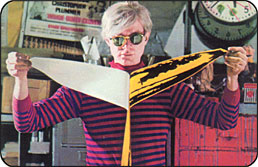
The origins of the banana cover art
 The origins of the banana cover art |
 |
Matt Wrbican* says: Andy Warhol created a print of the banana image at about the same time as the album design. The print, titled "Banana," is listed in the Catalogue Raisonne of his prints as number 11.10, dated "circa 1966," dimensions 61 x 135,2 cm, the peelable banana is 45,4 x 92,1 cm. No one knows which, the print or the album, was made first. Warhol also made several films in ca. 1964-66 (such as "Harlot") in which a banana was prominently featured. [* Matt Wrbican is Assistant Archivist at The Andy Warhol Museum] |
The specific banana image Andy chose came from I know not where; it's not chiquita banana or dole fruit company, because Andy's banana has 'overripe' markings on it, and the fruit companies use whole yellow bananas on their stickers. Anyway, Andy first used this particular banana image for a series of silk-screen prints which he screened on white, opaque, flexible, plexiglass (sort of like 2 feet x 5 feet). First an image of the inner banana 'meat' was screened on the plexi in pink, and then covered by the outer skin screened on and cut out of a glossy yellow sticky-back roll of heavy commercial paper (ordered from some supply warehouse). Thereby each banana could be peeled and the meat exposed and the skin could be replaced a number of times, til the sticky stuff wore out. Naturally this was intentionally erotic Warhol type art. When thinking of a cover for the first velvet album, it was easy for Andy to put one of his own works on the cover, knowing it was hip, outrageous, and original and would be 'really great'. Andy always went the easy way, using what he had, rather than puzzling and mulling over some design elements and graphics for cover art that don't really work. His art was already there, hip, erotic, and cool. The plexi silk screen art definitely came first in 1966, as Matt mentions. The album came out in '67. I do not recall any other design being thought of or even considered. The back of the album cover was a pastiche amalgam of photos from andy's films, Steven Shore, Paul Morrissey and myself and was messy and mulled over too much. [visit Billy Name website at http://billyname.com] |
 Unpeeled and peeled original mono copies (Coll. Olivier Landemaine) |
Special thanks to Matt Wrbican and Billy Name. designed by Olivier Landemaine ©1966-2004 The Velvet Underground Web Page |